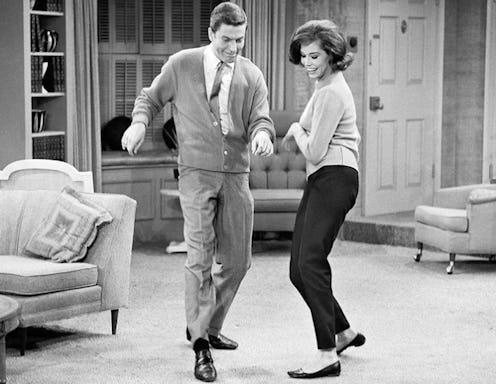
Women have had a long and hard history when it comes to their relationship with pants, which is why Mary Tyler Moore's capri pants may have been the most important costume on TV. Women had to fight for decades to be able to step outside of limited dress options, and Moore's experience was no different. A skirt was a woman's identity, so her wearing slacks would be seen as rebellious to the tenth degree.
Just a quick glance back gives us plenty of examples. Take the Le Smoking suit, for instance. According to Business Insider, when Yves Saint Laurent came out with the first female tuxedo in 1966, socialite Nan Kempner was turned away from an upscale restaurant and had to take off her slacks and wear her blazer as a dress to be allowed in. The host would rather have Kempner walk to her table wearing a butt-skimming mini dress than black slacks. Later, women in the '80s often times chose to wear skirt suits so as not to piss the men off even more for sharing office space with them. They wore pinstripes and blazers to hide their femaleness, but wore skirts so as not to inch in on their coworkers' masculinity. To go even further, women in Senate were banned from wearing pants until 1993 and Senator Barbara Mikulski's protest, Bloomberg Politics reported.
Mikulski and her female staffers agreed to show up at a meeting in slacks, and that paved the way for the skirt rule to be struck down.
These oppressive rules extended even into the sitcom realm, where Moore's capris while playing Laura Petrie on “The Dick Van Dyke Show” created such a shock, writers limited her to one pant scene an episode. She was one of the first women to wear pants on TV (in league with Lucille Ball,) and sponsors were so worried about the backlash that they had to reign in the amount of inseam-time to keep them from pulling out.
In an interview with NPR Moore explained it was all about the butt that made advertisers nervous. "They pointed specifically to — they used a term cupping under. And I can only assume that that meant my, you know, my seat, that there was a little too much definition. And so they allowed me to continue to wear them in one episode — one scene per episode and only after we check to make sure that there was as little cupping under as possible," Moore explained.
But not being one to take the male gaze and her immediate sexualization seriously, she and the writers started to sneak them into more scenes. "But within a few weeks, we were sneaking them into a few other scenes in every episode, and they were definitely cupping under and everyone thought it was great," Moore explained on NPR.
But the interesting thing was that Moore didn't insist on the pants as a staunch feminist stand. Instead, she wanted to give the show a dose of realism. "I've seen all the other actresses and they're always running the vacuum in these little flowered frocks with high heels on, and I don't do that. And I don't know any of my friends who do that," Moore remembered. "So why don't we try to make this real? And I'll dress on the show the way I do in real life."
Rather than letting the beautiful, obedient housewife trope extend into the '60s, Moore opted to change the script. She pulled for a sitcom to represent women in a non-cookie-cutter way, and that helped not only the image of women — but actual women watching at home — move forward.
And for that I'll always be thankful.
Images: Calvada Productions (4)